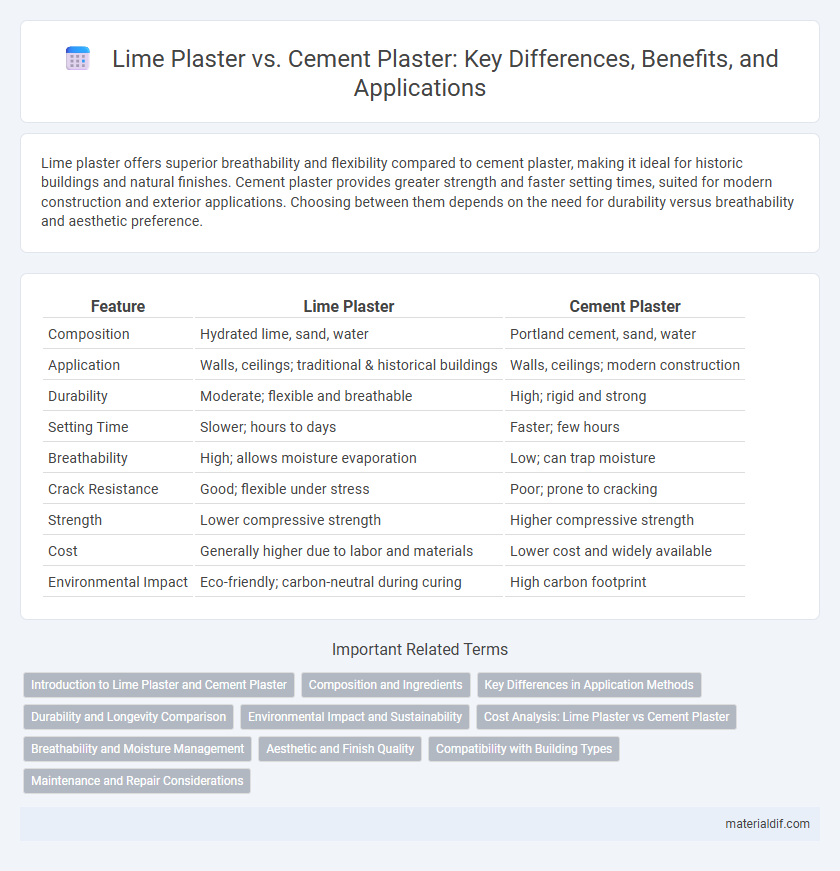Lime plaster offers superior breathability and flexibility compared to cement plaster, making it ideal for historic buildings and natural finishes. Cement plaster provides greater strength and faster setting times, suited for modern construction and exterior applications. Choosing between them depends on the need for durability versus breathability and aesthetic preference.
Table of Comparison
| Feature | Lime Plaster | Cement Plaster |
|---|---|---|
| Composition | Hydrated lime, sand, water | Portland cement, sand, water |
| Application | Walls, ceilings; traditional & historical buildings | Walls, ceilings; modern construction |
| Durability | Moderate; flexible and breathable | High; rigid and strong |
| Setting Time | Slower; hours to days | Faster; few hours |
| Breathability | High; allows moisture evaporation | Low; can trap moisture |
| Crack Resistance | Good; flexible under stress | Poor; prone to cracking |
| Strength | Lower compressive strength | Higher compressive strength |
| Cost | Generally higher due to labor and materials | Lower cost and widely available |
| Environmental Impact | Eco-friendly; carbon-neutral during curing | High carbon footprint |
Introduction to Lime Plaster and Cement Plaster
Lime plaster is composed primarily of lime putty or hydrated lime combined with sand and water, known for its breathability and flexibility, making it ideal for historic or moisture-prone buildings. Cement plaster consists of cement, sand, and water, offering high strength and durability, commonly used for exterior walls due to its resistance to weather and wear. Both materials serve as protective and decorative coatings but differ significantly in composition, application properties, and long-term performance.
Composition and Ingredients
Lime plaster consists primarily of slaked lime (calcium hydroxide) mixed with sand and water, offering flexibility and breathability ideal for historic and natural buildings. Cement plaster is made from a mixture of Portland cement, sand, and water, providing a harder, more durable surface but with reduced permeability. The chemical composition of lime plaster allows for carbonation and self-healing properties, whereas cement plaster cures through hydration, leading to a denser and less vapor-permeable finish.
Key Differences in Application Methods
Lime plaster is applied using multiple thin coats with a trowel, allowing it to breathe and cure naturally through carbonation, while cement plaster requires a rough base and is often applied thicker for durability and faster setting. Lime plaster necessitates a longer drying time and careful moisture control to prevent cracking, contrasting with cement plaster's quicker drying and stronger resistance to water. Application of lime plaster is typically manual and skill-intensive, whereas cement plaster can be applied faster and more uniformly, often using mechanical tools.
Durability and Longevity Comparison
Lime plaster exhibits superior durability in humid conditions due to its natural flexibility, allowing it to resist cracking and weathering over time better than cement plaster. Cement plaster, while harder and faster to set, tends to become brittle and may develop cracks, reducing its longevity in environments with frequent temperature fluctuations. The breathable nature of lime plaster enhances moisture evaporation, extending the lifespan of walls and preserving structural integrity longer than cement-based alternatives.
Environmental Impact and Sustainability
Lime plaster offers superior environmental benefits compared to cement plaster due to its lower carbon footprint and natural biodegradability, making it a more sustainable choice in construction. It absorbs CO2 during the curing process, helping to reduce greenhouse gases, while cement plaster relies heavily on energy-intensive Portland cement production, which emits significant CO2. The use of lime plaster also enhances indoor air quality through its breathable properties, promoting healthier living environments with reduced chemical exposure.
Cost Analysis: Lime Plaster vs Cement Plaster
Lime plaster typically costs more than cement plaster due to the higher price of raw lime and the labor-intensive application process. Cement plaster is generally more economical, benefiting from widely available materials and faster setting times, reducing labor expenses. Over time, lime plaster's durability and breathability can lower maintenance costs, potentially offsetting its higher initial investment compared to cement plaster.
Breathability and Moisture Management
Lime plaster offers superior breathability compared to cement plaster, allowing walls to naturally regulate moisture and reduce the risk of trapped dampness. Cement plaster forms a dense, less permeable layer that can inhibit moisture evaporation, potentially leading to mold and deterioration in historic buildings. Choosing lime plaster enhances moisture management in structures by facilitating vapor diffusion and maintaining healthier indoor environments.
Aesthetic and Finish Quality
Lime plaster offers a smooth, breathable finish that enhances wall aesthetics with a natural matte texture, allowing for subtle color variations and improved moisture regulation. Cement plaster provides a harder, more durable surface with a uniform finish, but it tends to crack over time and lacks the traditional charm of lime. The choice between the two impacts both the visual appeal and longevity of the plastered surface, with lime plaster favored for heritage and high-end interiors, while cement plaster suits modern, robust applications.
Compatibility with Building Types
Lime plaster is highly compatible with traditional and historic buildings due to its breathability and flexibility, allowing moisture to escape and preventing structural damage. Cement plaster suits modern construction, offering high durability and water resistance but can cause issues like cracking on older, more porous surfaces. Selecting plaster based on the building type ensures longevity and structural integrity while maintaining aesthetic value.
Maintenance and Repair Considerations
Lime plaster offers superior breathability and flexibility, reducing the risk of cracks and facilitating easier maintenance and repairs compared to cement plaster. Cement plaster is more rigid and prone to cracking, which can lead to more frequent and costly repair requirements. Choosing lime plaster can extend the lifespan of walls with lower maintenance efforts due to its natural self-healing properties.
Lime Plaster vs Cement Plaster Infographic

 materialdif.com
materialdif.com